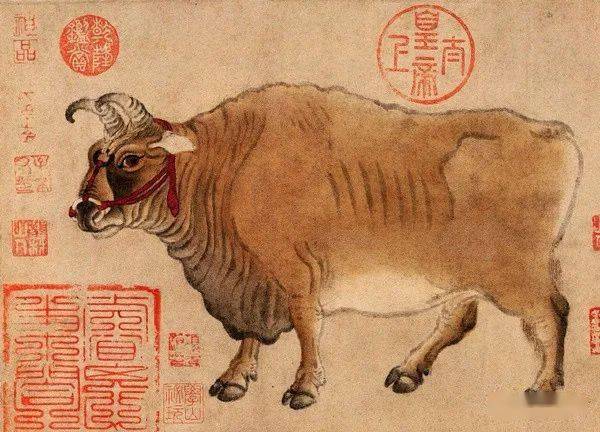Overview
Chinese Name: 五牛图
English Name: Five Oxen, Wuniutu
Year: Tang Dynasty 唐代
Artist: Han Huang 韩滉
Dimensions: 20.8*139.8 cm

Brief Introduction
Five Oxen 五牛图 was painted by the prime minister of Tang Dezong’s 唐德宗 period, Han Huang 韩滉. It is the earliest paper animal painting in China, with a history of more than 1,300 years. It is the only surviving boutique of the painter Han Huang 韩滉 of the Tang Dynasty 唐朝.

The painting was lost during the occupation of Beijing by the Eight-Nation Alliance 八国联军 in 1900 and later recovered from a collector in Hong Kong during the early 1950s. It is a national treasure and is now stored in the Palace Museum 故宫博物院 in Beijing.

Five Oxen 五牛图 is one of the Top 10 Chinese Paintings 中国十大传世名画. Five Oxen 五牛图 is one of the few genuine works of paper and silk paintings handed down from the Tang Dynasty, and it is also the oldest existing Chinese painting on paper with high historical and artistic value. This is unique in the history of Chinese and even world painting.
What is worth appreciating about this painting?
The meaningful and deep Themes
Five Oxen 五牛图 is permeated with strong personal emotions. The five bulls refer to Han Huang’s 韩滉 five brothers. With the character of a heavy-duty, hard-working, and docile bull, he expresses his true feelings of love and loyalty to the emperor.
According to historical records, during his tenure as prime minister, Han Huang韩滉 paid great attention to the development of agriculture. He used cattle as the subject, which may also have the meaning of encouraging farming.

This picture is a hand-scroll group painting, with cattle as the object of expression. Because there is no background to set off, it is really difficult to consider the arrangement of the composition pattern, and it is not easy to express it very distinctively. The painter Han Huang 韩滉 handles this problem relatively well by adopting the form of left and right symmetry in composition processing.

The structure is rigid
The five oxen are not only a single individual, but also have a close relationship with each other, which constitutes a very harmonious unified whole. Although the five cows are arranged in parallel on the picture, through their dynamic features of raising their heads, bowing their heads, looking back and looking left and right, the picture does not appear rigid, and the subtle changes in the composition can be seen in the interaction and contact with each other.

From right to left, the first is an old brown cow, depicted as biting something while tickling beside a weed, with a leisurely attitude; the second is a black and white mixed-flowered cow, with a strong body, wagging its head and tail, and walking steadily.
The three are dark ochre-colored old cows, with jagged muscles and bones, humming vertically, white mouths and bright eyebrows, and old-fashioned bells. The fourth is an ox, with a tall body and towering horns, looking back; The fifth cow, standing with its head on its head, has a sturdy body, is thoughtful, and has a stubborn personality.
The Painting Techniques
In the use of techniques, the painter Han Huang 韩滉 outlines the cow with strong and powerful ink lines, showing the cow’s robustness, composure and slowness of action.
In particular, the careful rendering of the cow’s eyes, nose, hoof toes, and whiskers highlights the cow’s strong muscles and bones and the real texture of the fur. Black and white represent the most typical cow coat color. Although only two colors are used, it gives people a rich and colorful feeling.

“The finishing touch” is the key to affecting the overall situation. The painter exaggerates the bull’s eye and deliberately depicts it, so that the five bull’s eyes are piercing, reaching the artistic realm of both form and spirit.
The five oxen all have bright eyes, deep and expressive, and vividly express the docile and stubborn character of the ox. The viewer can clearly feel that these five cows not only have life and emotions, but also have their own different inner worlds. This is the personified five cows.
The Artist of the painting
Han Huang 韩滉 was a statesman and painter in the mid-Tang Dynasty 中唐时期, and the son of the prince’s junior teacher Han Xiu 韩休.
Han Huang’s calligraphy, the cursive calligraphy of Zhang Xu 张旭. Painting studied under the Southern Song Dynasty 南宋时期 Lu Tanwei 陆探微. Han Huang is good at painting figures and rural customs and scenery, especially animals such as cows, sheep, and donkeys. The “Five Oxen”, Zhao Mengfu 赵孟頫 praised it as “a high-spirited and well-known pen”.

Han Huang 韩滉 is particularly fond of drawing the customs of the rural areas, depicting the things of the peasant family and the customs and characters. The pastoral genre paintings of farm production and life scenes occupy an important position in Han Hong’s paintings.
